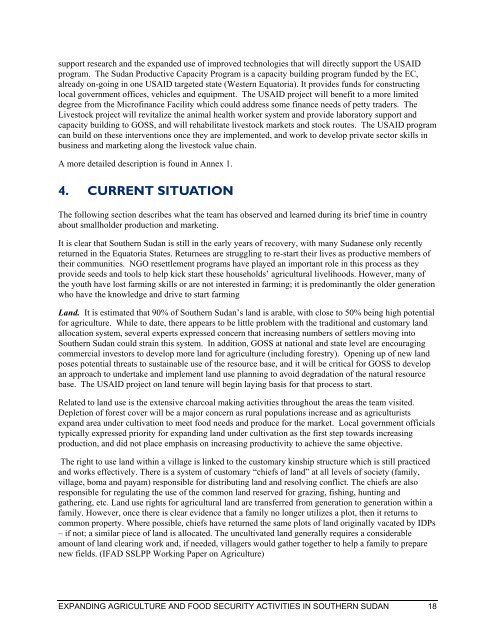expanding agriculture and food security activities in ... - part - usaid
expanding agriculture and food security activities in ... - part - usaid
expanding agriculture and food security activities in ... - part - usaid
You also want an ePaper? Increase the reach of your titles
YUMPU automatically turns print PDFs into web optimized ePapers that Google loves.
support research <strong>and</strong> the exp<strong>and</strong>ed use of improved technologies that will directly support the USAID<br />
program. The Sudan Productive Capacity Program is a capacity build<strong>in</strong>g program funded by the EC,<br />
already on-go<strong>in</strong>g <strong>in</strong> one USAID targeted state (Western Equatoria). It provides funds for construct<strong>in</strong>g<br />
local government offices, vehicles <strong>and</strong> equipment. The USAID project will benefit to a more limited<br />
degree from the Microf<strong>in</strong>ance Facility which could address some f<strong>in</strong>ance needs of petty traders. The<br />
Livestock project will revitalize the animal health worker system <strong>and</strong> provide laboratory support <strong>and</strong><br />
capacity build<strong>in</strong>g to GOSS, <strong>and</strong> will rehabilitate livestock markets <strong>and</strong> stock routes. The USAID program<br />
can build on these <strong>in</strong>terventions once they are implemented, <strong>and</strong> work to develop private sector skills <strong>in</strong><br />
bus<strong>in</strong>ess <strong>and</strong> market<strong>in</strong>g along the livestock value cha<strong>in</strong>.<br />
A more detailed description is found <strong>in</strong> Annex 1.<br />
4. CURRENT SITUATION<br />
The follow<strong>in</strong>g section describes what the team has observed <strong>and</strong> learned dur<strong>in</strong>g its brief time <strong>in</strong> country<br />
about smallholder production <strong>and</strong> market<strong>in</strong>g.<br />
It is clear that Southern Sudan is still <strong>in</strong> the early years of recovery, with many Sudanese only recently<br />
returned <strong>in</strong> the Equatoria States. Returnees are struggl<strong>in</strong>g to re-start their lives as productive members of<br />
their communities. NGO resettlement programs have played an important role <strong>in</strong> this process as they<br />
provide seeds <strong>and</strong> tools to help kick start these households’ agricultural livelihoods. However, many of<br />
the youth have lost farm<strong>in</strong>g skills or are not <strong>in</strong>terested <strong>in</strong> farm<strong>in</strong>g; it is predom<strong>in</strong>antly the older generation<br />
who have the knowledge <strong>and</strong> drive to start farm<strong>in</strong>g<br />
L<strong>and</strong>. It is estimated that 90% of Southern Sudan’s l<strong>and</strong> is arable, with close to 50% be<strong>in</strong>g high potential<br />
for <strong>agriculture</strong>. While to date, there appears to be little problem with the traditional <strong>and</strong> customary l<strong>and</strong><br />
allocation system, several experts expressed concern that <strong>in</strong>creas<strong>in</strong>g numbers of settlers mov<strong>in</strong>g <strong>in</strong>to<br />
Southern Sudan could stra<strong>in</strong> this system. In addition, GOSS at national <strong>and</strong> state level are encourag<strong>in</strong>g<br />
commercial <strong>in</strong>vestors to develop more l<strong>and</strong> for <strong>agriculture</strong> (<strong>in</strong>clud<strong>in</strong>g forestry). Open<strong>in</strong>g up of new l<strong>and</strong><br />
poses potential threats to susta<strong>in</strong>able use of the resource base, <strong>and</strong> it will be critical for GOSS to develop<br />
an approach to undertake <strong>and</strong> implement l<strong>and</strong> use plann<strong>in</strong>g to avoid degradation of the natural resource<br />
base. The USAID project on l<strong>and</strong> tenure will beg<strong>in</strong> lay<strong>in</strong>g basis for that process to start.<br />
Related to l<strong>and</strong> use is the extensive charcoal mak<strong>in</strong>g <strong>activities</strong> throughout the areas the team visited.<br />
Depletion of forest cover will be a major concern as rural populations <strong>in</strong>crease <strong>and</strong> as agriculturists<br />
exp<strong>and</strong> area under cultivation to meet <strong>food</strong> needs <strong>and</strong> produce for the market. Local government officials<br />
typically expressed priority for <strong>exp<strong>and</strong><strong>in</strong>g</strong> l<strong>and</strong> under cultivation as the first step towards <strong>in</strong>creas<strong>in</strong>g<br />
production, <strong>and</strong> did not place emphasis on <strong>in</strong>creas<strong>in</strong>g productivity to achieve the same objective.<br />
The right to use l<strong>and</strong> with<strong>in</strong> a village is l<strong>in</strong>ked to the customary k<strong>in</strong>ship structure which is still practiced<br />
<strong>and</strong> works effectively. There is a system of customary “chiefs of l<strong>and</strong>” at all levels of society (family,<br />
village, boma <strong>and</strong> payam) responsible for distribut<strong>in</strong>g l<strong>and</strong> <strong>and</strong> resolv<strong>in</strong>g conflict. The chiefs are also<br />
responsible for regulat<strong>in</strong>g the use of the common l<strong>and</strong> reserved for graz<strong>in</strong>g, fish<strong>in</strong>g, hunt<strong>in</strong>g <strong>and</strong><br />
gather<strong>in</strong>g, etc. L<strong>and</strong> use rights for agricultural l<strong>and</strong> are transferred from generation to generation with<strong>in</strong> a<br />
family. However, once there is clear evidence that a family no longer utilizes a plot, then it returns to<br />
common property. Where possible, chiefs have returned the same plots of l<strong>and</strong> orig<strong>in</strong>ally vacated by IDPs<br />
– if not; a similar piece of l<strong>and</strong> is allocated. The uncultivated l<strong>and</strong> generally requires a considerable<br />
amount of l<strong>and</strong> clear<strong>in</strong>g work <strong>and</strong>, if needed, villagers would gather together to help a family to prepare<br />
new fields. (IFAD SSLPP Work<strong>in</strong>g Paper on Agriculture)<br />
EXPANDING AGRICULTURE AND FOOD SECURITY ACTIVITIES IN SOUTHERN SUDAN 18

















